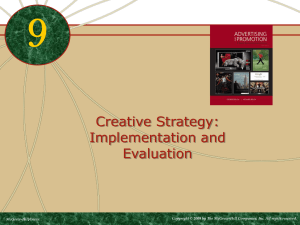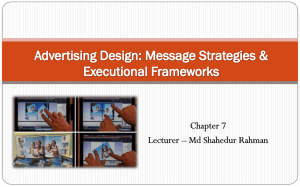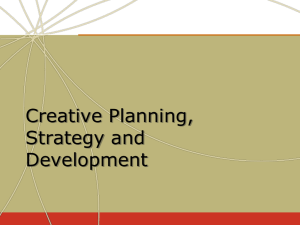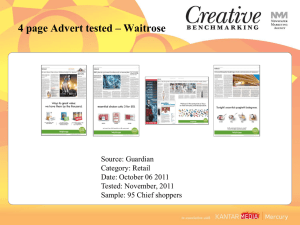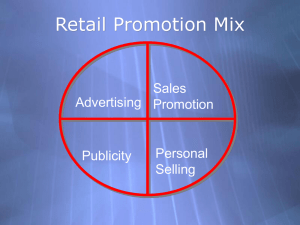marketing chapter notes
advertisement
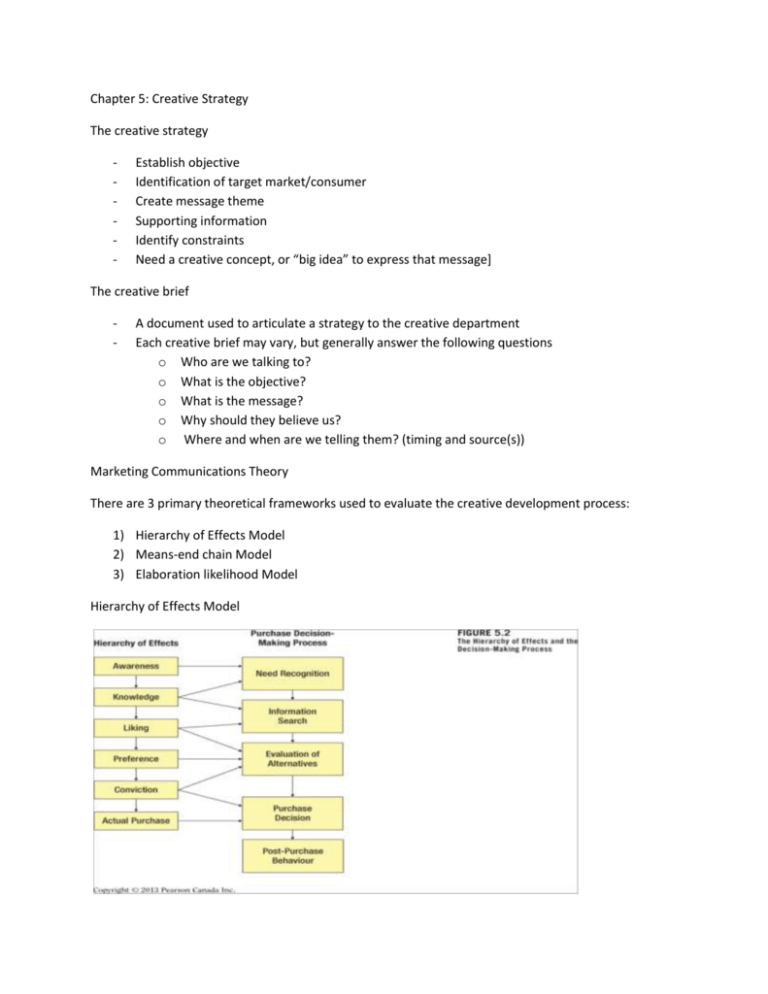
Chapter 5: Creative Strategy The creative strategy - Establish objective Identification of target market/consumer Create message theme Supporting information Identify constraints Need a creative concept, or “big idea” to express that message] The creative brief - A document used to articulate a strategy to the creative department Each creative brief may vary, but generally answer the following questions o Who are we talking to? o What is the objective? o What is the message? o Why should they believe us? o Where and when are we telling them? (timing and source(s)) Marketing Communications Theory There are 3 primary theoretical frameworks used to evaluate the creative development process: 1) Hierarchy of Effects Model 2) Means-end chain Model 3) Elaboration likelihood Model Hierarchy of Effects Model - - - Suggests there are 6 steps a consumer or a business buyer moves through when making a purchase This model can help a creative understand how a customer reaches purchase decisions Not completely accurate, 6 steps not always the route taken o Someone makes an impulse buy and later develops knowledge, liking, preference, and conviction o Shoppers may purchase with little or no preference because of purchase incentives like coupons and discounts cause them to choose one brand over the other Benefits of this model are it is one method used to identify typical steps consumers/businesses take when making purchases, all six must be included to encourage brand loyalty Creative development can take into account these processes (cognitive, affective, conative) and develop communications that help the audience move through each phase of attitude development The FCB grid is a useful tool in the evaluation of hierarchy of effects model for a given product: Rational Emotional High Involvement Process: Process: Cognitive->Affective->Conative Affective->Cognitive->Conative Example: Example: Appliances Clothing/Fashion Critical campaign elements: Critical campaign elements: Websites/newspapers Magazine/Out-of-home Low Involvement Process: Process: Conative->Cognitive->Affective Conative->Affective->Cognitive Example: Example: Frozen Food Chewing Gum Critical campaign elements: Critical Campaign Elements: Coupons/Sampling Point of sale Means-End Theory - This model suggests that marketing communication should contain a message, means that leads the consumer to a desired end state The end states include personal values such as: o Comfortable life, equality, freedom, happiness, personal accomplishment, security etc. The purpose is to start a process in which the marketing communications leads to the consumer believe that using the product will help them reach on of these personal values The theory is the basis of a model called the Means-End Conceptualization of Components for Advertising Strategy (MECCAS) The MECCAS is also used in business to business messages The MECCAS model suggests using 5 elements in creating ads: o The product attributes o Consumer benefits o o o Leverage points Personal values Message tactics Importance of the Leverage Point - Both the hierarchy of effects and the means end chain model lead to a leverage point The feature of the ad that leads the viewer to transform the advertising message into personal value To be affective it must build a pathway that connects a products benefits with the potential buyers value system Elaboration Likelihood Model (ELM) - This model examines how likely a person is to spend time thinking deeply (elaborating) about any specific piece of marketing communication Premise is that marketing communications influences audiences based on how much the audience thinks about the message There are 3 routes in which consumers process messages: 1) Central Route- audience processing of a message that uses arguments or information presented in the message 2) Peripheral Route- audience processing of a message that focuses on cues, such as spokespeople, images or colors 3) Low Involvement Route- audience persuasion that occurs even when an audience is not actively processing a marketing communications message Types of Marketing Communications Appeals Rational Appeals Emotional Appeals Fear Commonly used as a base for messages - Numerous companies use fear to sell their Price is often relative to competitors prices products i.e. life insurance, dandruff Typical in sales promotions such as shampoo coupons - Fear appeals can be highly effective if used correctly - The behavior response model helps to explain the way a fear appeal can work Performance Humor - Usually involve some sort of value - Used in 30% of all advertisements equation by the consumer - Excellent of capturing attention - A premise of outperforming their - Score high in recall tests competitors - Should be related directly to customer benefits - Humor causes audiences to: Watch, laugh, remember - Reasons for humor ads: Captures attention, holds attention, often wins creative awards, high recall scores, consumers enjoy funny ads, evaluated as likable ads Price - Scarcity Based on limited supply - Based on limited time to purchase - Often tied with promotion tools such as contests, sweepstakes and coupons - Encourages customer to take action Sex - Like humor, this type of appeal can break through clutter Sex appeals can be presented in different matters: Subliminal techniques- only registers in subconscious mind Nudity or Partial Nudity Sexual suggestiveness- gay and lesbian themes, encourages use of imagination, requires greater mental processing Overt sexuality – used for products that are sexually oriented Sensuality – more sophisticated approach b/c relies more on imagination Rational Appeals - Based on the Hierarchy of Effects Model Print Media is well suited for rational appeals Used by business to business advertisers Well suited for complex and high involvement products Emotional Appeals - - Based on 3 ideas: 1) Consumers ignore most ads 2) Rational ads go unnoticed 3) Emotional ads can capture attention Viewed by creatives as key to developing brand loyalty Are sex appeals effective? - Sex and nudity do increase attention Rated as being more interesting Often leads to strong feelings about the advertisement Brand recall is lower than messages using other appeals People pay attention however not to the brand but to the sexual theme Often interferes with message comprehension Controversial ads are more interesting but they fail to increase the transmission of information May impact feelings toward the brand: pleasant of offensive? Chapter 6: Creative tactics and advertising strategies Message strategies are used to deliver a message theme Message Tactics - - Cognitive Tactics o The presentation of rational arguments or pieces of information to consumers designed to stimulate cognitive processing o Generic messages Direct presentations of product attributes or benefits without any claim of superiority Works best when firm is clearly the brand leader and is dominant company The goal of generic message is to make brand synonymous with product category Ex. Campbells soup, Intel micro chips Good tactic for creating brand awareness Develop cognitive linkages between specific brand name and product category May not give much on product attributes but purpose to simply put the brand name in a person’s cognitive memory o Preemptive messages Claim superiority based on products specific attribute or benefit Purpose to be first company to state the advantage Ex. Crest toothpaste “ the cavity fighter” o Unique Selling Proposition (USP) An explicit, testable claim of uniqueness or superiority that can be supported or substantiated in some manner Ex. Kal Tire sells die hard battery that is “best selling” automotive battery o Hyperbole Approach Makes an untestable claim based on upon some attribute or benefit Ex “the number 1 movie in America” o Comparative messages When a marketer directly or indirectly compares a good or service to the competition ad may or may not mention competitors name (more effective if named) when comparisons are made both brand and message awareness increase Negative side is many consumers think comparative messages are less believable Negative comparative messages have lower believability Affective Tactics o Invoke feelings or emotions and match those feelings with the good, service, or company o - Such messages are prepared in order to enhance the likability of the product, recall of the appeal, or comprehension of the message o Affective tactics are a common approach to developing strong brand name o Affective->Conative->Cognitive When an ad gets you to like a brand and have positive feelings for a brand the hope is you will buy the brand then you cognitive beliefs about the brand will follow o Ex. Porch ad Conative Tactics o Are designed to lead more directly to some type of consumer response o The goal is to elicit behavior, ads encourage quick action stating that it can only be purchased for limited time o Action inducing messages Create situations in which cognitive knowledge of a product or affective liking of the product may come later (after actual purchase) or during product usage Ex. POP displays are designed for people to make impulse buys Conative->Cognitive->Affective Executional Frameworks An executional framework is the manner in which an appeal tactic is presented - Slice of Life o Made famous by P&G in 1950’s o Messages normally show common experiences and specially the problems in which people encounter, then the good or service is made available to solve the problem o Good for B2B messages o Is an excellent example of how one framework can be used to manifest either a rational or emotional appeal - Animation o Growing popularity in recent years with available graphics technology o Initially only used by firms with low advertising budget o Animated characters as spokespeople cannot have bad reputation, publicity - - - - - - o Recently has been an effective framework for B2B Dramatization o Similar to slice of life, it uses the same format in which the problem is presented then a solution is offered o Uses a higher level of excitement and suspense to tell the story o Builds on crisis point leading to suspenseful climax o Not all dramatic execution styles can accomplish the high level suspense often making it easier to use slice of life Demonstration o Shows how the product works o B2B messages often present demonstrations o Well suited for television and internet media Fantasy o Designed to lift the audience beyond the real world to a make-believe experience o The more irrational and illogical a message the more clearly consumers recall them o This approach commonly used with products targeted at homemakers Informative o Present info to the audience in a straightforward manner o Less common in television and print and used mainly for only verbal communication such as radio o Other communications tools such as sales promotions often rely heavily on informative executions because they simply present a deal o Have limited uses but can be effective when placed properly Testimonials o When a customer is presented in a message telling about a positive experience with the product o Testimonials provide references in advance o Strong framework for B2B marketing, more people believe what others say about a company more than the company o Also great in promoting services b/c they are intangible: they cannot be seen or touched Authoritative o In this framework the marketer is seeking to convince the audience that a given product is superior to other brands o Presented by and expert or authority in a particular field and often include some type of scientific survey or evidence o Assumes consumers and business decision makers rely on cognitive processes when making purchase decisions This means that they will pay attention to the message and carefully think about the message conveyed Sources of Spokespersons - - Celebrities o Unpaid spokespeople o Celebrity voiceovers o Dead-person endorsements CEO’s Experts Typical Persons Matching Source Types and Characteristics - - - - Celebrities o Tend to score high on credibility o Negative publicity o Endorsement of too many products CEO o Trustworthy, expertise, and some credibility o Must exercise care in selection Expert o Seek experts who are attractive, likable, trustworthy o Valid credentials important Typical person o Multiple typical persons increase credibility o Real person vs actor Principles of effective advertising (consistency) - Visual and verbal consistency Campaign duration Repeated messages and taglines Consistent positioning Simplicity Identifiable selling point Effective flow of message Variability theory o Theory suggests encoding occurs when consumer sees the same message in different environments over time, hey increase recall and effectiveness by encoding the message into the brain through various methods o Same message in different environments and media Beating Ad Clutter - Use repetition - Variability Theory Use Multiple Mediums Create ads that gain attention Create ads that relate to the target audience Chapter 7: Advertising Media Planning - Focus on consumer behavior Create plans that reflect the purchase process (Chapter 3) Positively influence consumer in the marketplace Study media choices Listening and viewing habits Factors that have changed the role of Media - IMC- more than just mass advertising now Cost factors Technology Globalization Complexity of the media function Profitability Media Selection Factors Reasons as to why certain media are selected: - Organization Objectives Target markets(s) Costs Message theme Constraints Product/Service considerations Media Selection - - Media selection factors influence our marketing communications mix Marketing communications mix- the combination of tools used to promote a product or service. Could include, but not limited to, advertising media (many forms), sales promotions, public relations and digital and social media Selecting Media o TV o Radio o Transit o Billboard o Outdoor/Out-of-home o Internet o Magazines o Newspapers o o Direct Mail Alternate Media Developing Logical Combinations of Media Achieving Advertising Objectives 1) Three-exposer hypothesis o Intrusion Value o Takes minimum of three exposers for an ad to be effective o Effective Frequency- number of times that one must be exposed to a message to achieve its objective o Effective Reach- percent of target market that must be exposed to ad to achieve its objective o Size, placement, length of ad are factors to consider o Number of media used is important (variability) 2) Recency Theory o One exposer may be enough o Effective the closer to a purchase o States that consumers use selective retention when they consider ads o Advertising is a waste of money of intended market is not reached 3) Media Multiplier Effect o The combined impact of using two or more media is stronger than using either medium alone o Often the reason for using several different media o This ensures a broader effective reach Ad Campaign Continuity Continuous Campaign: Advantages - Serves as a constant reminder to the customer Covers the entire buying cycle Disadvantages - Higher Costs Potential of over exposer effect Flighting Campaign: Advantages - Cost efficiency of advertising, only used during purchase cycles Allows for more than one medium or vehicle on limited budgets Disadvantages - Lack of awareness, interest, retention or promotional message during non-scheduled times -> could lead to decay Pulsating Campaign: Advantages - Same as two previous methods Disadvantage - Not required for seasonal products, or other cyclical products, therefore adding to organizations expenses Advertising Terminology Reach- number in target audience exposed, typically 4 week period Frequency- average number of exposers within a given period Opportunities to see \

